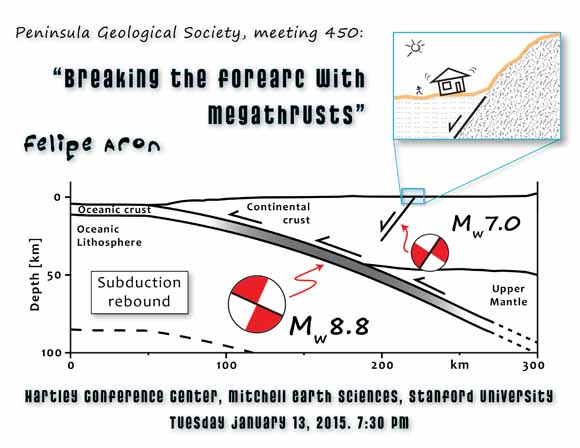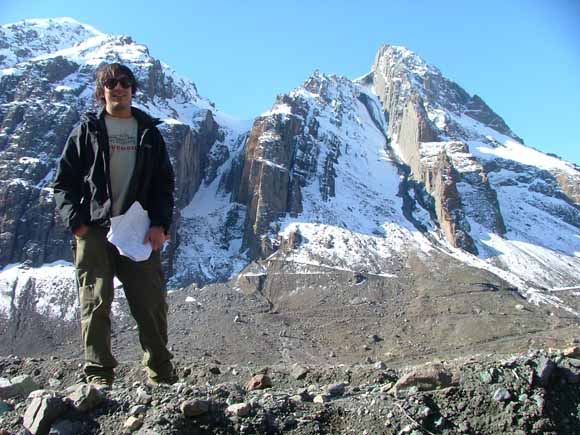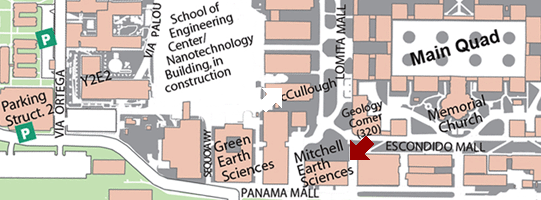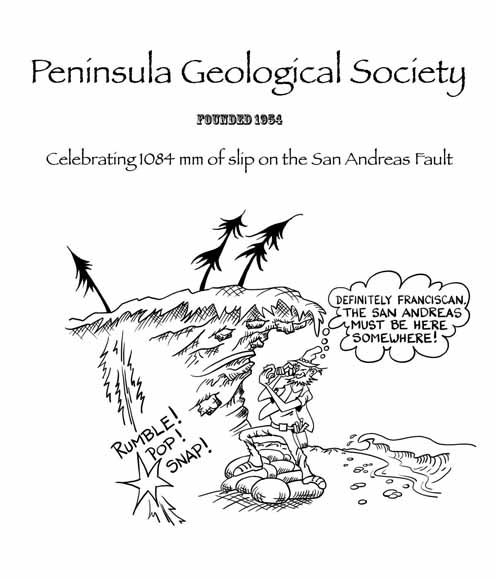
Presents
Location: Stanford University
This will be the 450th meeting since 1954

I have used geological, geophysical and engineering methods to explore mechanisms of upper plate, brittle deformation at active forearc regions. Over this presentation I will particularly address the permanent deformation style experienced by the forearc following great subduction ruptures, such as the 2010 Mw8.8 Maule, Chile and 2011 Mw9.0 Tohoku, Japan earthquakes. These events triggered large, shallow seismicity on upper plate normal faults above the rupture reaching Mw7.0. First I will present new structural data from the Chilean Coastal Cordillera over the rupture zone of the Maule earthquake. The study area contains the Pichilemu normal fault, which produced the large crustal aftershocks of the megathrust event. Normal faults are the major neotectonic structural elements of the Andean forearc but reverse faults also exist. Crustal seismicity and GPS surface displacements show that the forearc experiences pulses of rapid coseismic extension, parallel to the heave of the megathrust, and slow interseismic, convergence-parallel shortening. These cycles, over geologic time, build the forearc structural grain, reactivating structures properly oriented respect to the deformation field of each stage of the interplate cycle. Great subduction events may play a fundamental role in constructing the crustal architecture of extensional forearc regions. Then I use static mechanical models of coseismic and interseismic upper plate deformation to explore for distinct features that could result from brittle fracturing over the two stages of the interplate cycle. I will show that the semi-elliptical outline of the first-order normal faults along the Coastal Cordillera may define the location of a characteristic, long-lived megathrust segment. Finally, using data from the Global CMT catalog I analyze the seismic behavior through time of forearc regions that have experienced great subduction ruptures >Mw7.7 worldwide. Between 61% and 83% of the cases where upper plate earthquakes exhibited periods of increased seismicity above background levels occurred contemporaneous to megathrust ruptures. That correlation is stronger for normal fault events than reverse or strike-slip crustal earthquakes. More importantly, for any given megathrust the summation of the moment accounted by the forearc normal fault aftershocks, when expressed as Mw, appears to have a positive linear correlation with the Mw of the subduction earthquake—the larger the megathrust the larger the energy released by forearc events.

Felipe Aron
Felipe Aron received his B.S. (Licenciatura) in Geology (with great honor, con distinción) in 2007 from the Universidad Cató'lica del Norte (UCN), Antofagasta, Chile. A year later, he received his Professional Title (Título Profesional), Geologist from UCN. In 2014 he received his Ph.D. in Geological Sciences from Cornell University. He is presently a Postdoctoral Research Fellow in the Department of Geological and Environmental Sciences at Stanford University. Felipe is a structural geologist working with geological, geophysical, tectonic geomorphology and engineering methods to study earthquake geology and active tectonics, analysing the response of the landscape to fault activity. He is using differential uplift rates captured by steepness changes along channel profiles over the Southern Santa Cruz Mountains in central California, aiming to reconcile long- and short-term patterns of deformation related to repeated earthquakes on major thrust faults bounding the western edge of the Silicon Valley. Since late August, 2014 he has been a member of the Tectonic Geomorphology lab at Stanford and he conducts his research with the help of his supervisor George Hilley.
Reservations: The preferred way to make reservations is simply to email Mike Diggles at mike@diggles.com by Jan. 11, tell him you will attend, commit to pay, and bring your payment to the meeting. Mike always emails a confirmation; if you don’t get one, assume email crashed yet again and email him a second time. A check made to “PGS” is preferred, payable at the meeting.
If you want to pay in advance:
Everyone (including Stanford folks now) Please make dinner reservations by Jan. 11. Contact Mike Diggles, at U.S. Geological Survey, 345 Middlefield Road, MS-910 Menlo Park, CA 94025, Tel.: (650) 329-5404. Send check made out to “PGS” to Mike.
Dinner and the social hour is $35.00; this includes $5 that we use to help pay for students who are only $8.00 (also partially subsidized thanks to the School of Earth Sciences, Stanford University (Note, no-show reservations owe the full price).
Doris, whose wonderful crew prepares our meals, asked that we let you know that people who are late RSVPing and people who show up without a reservation will be welcome but that they may be eating on paper plates with plastic utensils (food supply permitting).
Dues for Academic Year 2014-2015 ($10.00) should be sent to Mike Diggles, U.S. Geological Survey, 345 Middlefield Road, MS-910, Menlo Park, CA 94025. Mike’s phone: (650) 329-5404.
Officers: Brad Buerer, President; Sarah Nagorsen, Vice President; Mike Diggles, Secretary-Treasurer; Elizabeth Miller, PGS Stanford University Coordinator


PGS cartoon by Rick Blakely
Date created: January 4, 2015
Last modified: June 6, 2015
Created by: Mike Diggles, Webmaster-Secretary-Treasurer, PGS.